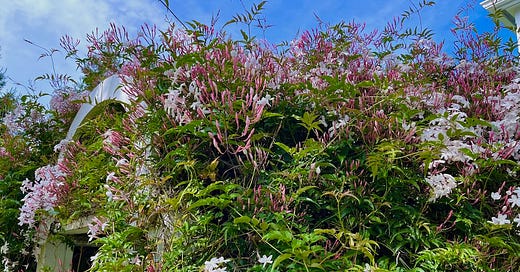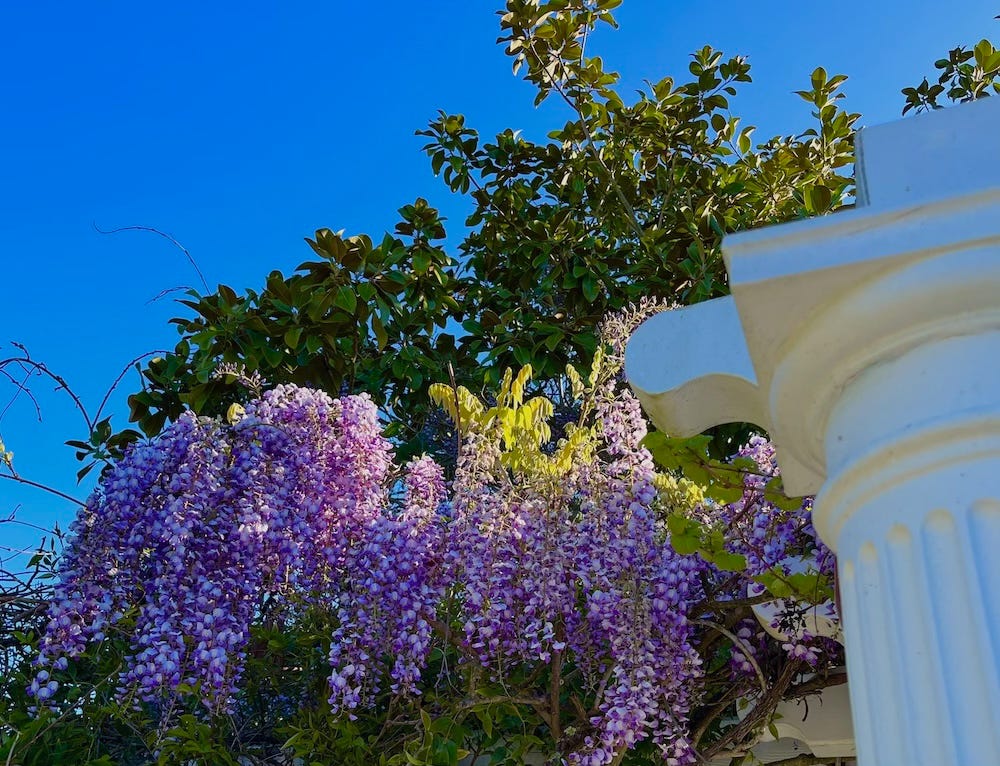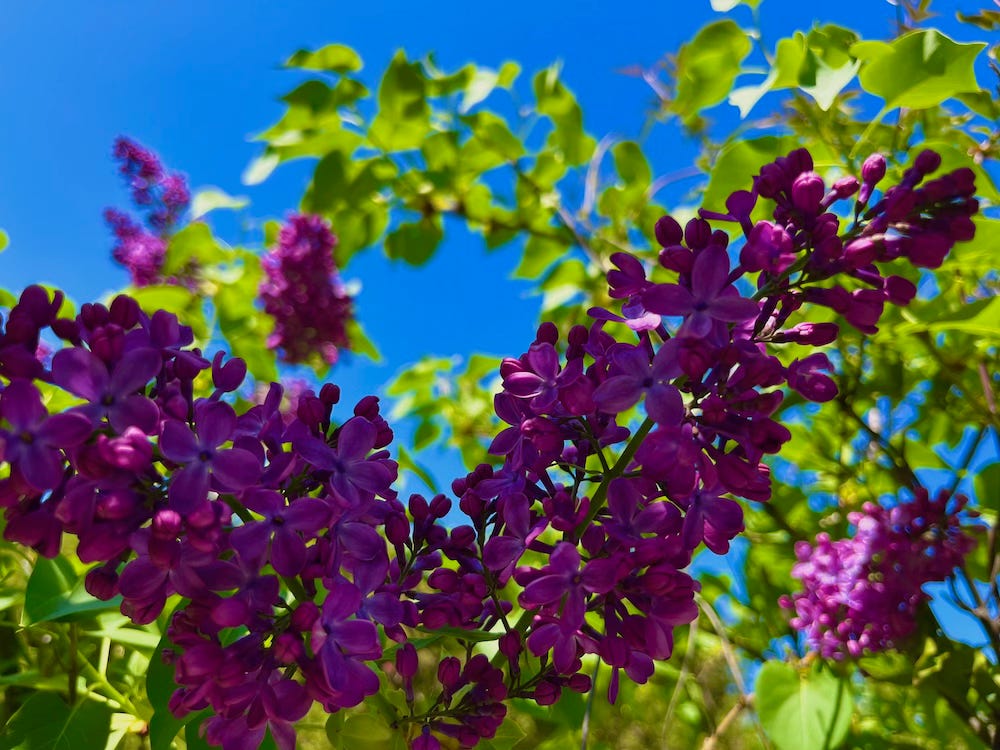“Nature teaches us that even the most delicate vines can reach great heights with the right support.” Oprah Winfrey
Getting out of my car, the perfume emanating from my garden smells more like being inside the cosmetic department at a store. Flowing over my front gate and arbor, the jasmine is thick in its wondrous white wardrobe. Bees are buzzing as the intoxicating fragrance fills the air. A robust climber, the blooms from this gregarious vine are one of the most sought-after scents to make expensive perfumes and flavored teas. But jasmine has a dark side: it can be invasive. It grows so vigorously that it can strangle trees, shrubs, and flower beds. Wherever a stem touches the ground, a new vine will root. Jasmine thrives in sunlight and the blossoms prefer to face the sun. Keep it pruned and under control, or you may find that it will take over your landscape.
Climbers, vines, or plants that climb have specialized structures that allow them to ascend and cling to surfaces for support. I love many of them and you may also.
What are a few of the most popular climbing plants besides jasmine?
Clematis
Wisteria
Passionflower
Trumpet Vine
Grapevine
Climbing Roses
Nasturtium
ü Clematis is renowned for its beautiful blooms, long-flowering with a plethora of colors, shapes, and climate exposure. There are over 300 species and hundreds of hybrids.
ü Wisteria vines produce romantic cascades of fragrant pendulous blossoms in lavender, pink, and white that resemble bunches of grapes. Their vigorous vining capabilities require a very sturdy structure.
ü Passionflower is delicate and exotic-looking, climbing with tendrils on trellises, encompassing more than 400 species. Heady-perfumed flowers appear on new growth as pollinators flock to the garden.
ü Trumpet vine, native to Eastern North America, boasts trumpet-shaped flowers that attract hummingbirds in glorious shades of red, pink, scarlet, purple, and yellow
ü Climbing Roses can drape over a wall, sprawl along a fence, train up an obelisk, or swirl up a tree. In my yard, my two favorite climbers are the thornless, white Lady Banksia rose which cohabitates with my plum and chestnut trees, and the delightfully fragrant Lady of Shallot in shades of apricot and pink that covers a fence.
ü Nasturtium is a delicious edible plant with a zesty, peppery flavor. Flowers with bold colors of yellow, red, and orange trail and climb.
Popular Climbers NOT to plant:
Honeysuckle
Morning Glory
Ivy
As beautiful as honeysuckle and morning glory are, they can also be incredibly invasive, displacing native species, producing dense mats of foliage, and covering trees, fences, or any item in their path. In some settings, they increase the erosion of the soil while reducing biodiversity. I remember my first visit to Bermuda thirty years ago where I was mesmerized by the giant and glorious sky-blue flowers that covered everything everywhere. When I asked about the “magnificent morning glory”, my comment was met with disdain. “This is a nuisance plant,” I was told. Just as bindweed is a troublemaker in our gardens, controlling morning glory is a challenge. The “easy-to-grow” or “no-fail” honeysuckle called “Hall’s Prolific” is marketed to new gardeners, but these are invasive species. The non-invasive honeysuckle, from the genus Diervilla, is native to North America and an essential part of our ecosystem providing food for native insects. If you want honeysuckle, plant Diervilla. As a self-adherent aerial plant, ivy is an aggressive climber that can wreak havoc on structures, buildings, walls, and trees. Highly flammable ivy harbors rodents and is extremely difficult to eradicate. These three specimens are what I call the “anti-social climbers”. Delete them from your most-wanted list.
Why do you want to include climbing plants in your garden design? The reasons are numerous and desirable.
ü Vertical Interest: Climbing plants allow for more dynamic and layered landscapes as we look up.
ü Climbers can cover arbors, trellises, fences, pergolas, and walls, adding depth and texture.
ü Space Optimization: Climbing plants are space-savers, especially for small gardens or urban settings where space is limited. Because they grow vertically, they make efficient use of space while making a big impact.
ü Privacy and Screening: This may be one of the best reasons for growing climbers. By growing up, they provide a natural privacy barrier, offering seclusion with the added benefit of beauty and most often, fragrance.
ü Aesthetic Appeal: With their beautiful cascading flowers, foliage, or fruit, climbers create a lush and romantic atmosphere.
ü Wildlife Habitat: Biodiversity is established in the garden as most climbers attract birds, butterflies, bees, hummingbirds, and other pollinators. They offer food, shelter, and nesting sites for various creatures which contribute to a healthy ecosystem.
ü Versatility: Vines, creepers, scramblers, and climbers can be trained to grow in diverse directions and on several structures to customize landscapes.
Other than nasturtiums, all the climbers require heavy-duty, solid support structures to grow and flourish successfully. If you want to keep the climbers “social”, it is necessary to prune, maintain, and be watchful, or else they will land in the “anti-social” profile. With careful management and thought, climbers will add beauty, functionality, privacy, and ecological benefits to your garden. Enhance your outdoor space with spectacular social climbers reaching great heights with the right support.
Happy Gardening. Happy Growing!
Read Lamorinda Weekly: https://lamorindaweekly.com/archive/issue1805/Digging-Deep-with-Goddess-Gardener-Cynthia-Brian-Social-Climbers.html
Read Press Pass: https://www.vapresspass.com/2024/04/30/garden-climbers/
For more gardening advice for all seasons, check out Growing with the Goddess Gardener at https://www.CynthiaBrian.com/books. Raised in the vineyards of Napa County, Cynthia Brian is a New York Times best-selling author, actor, radio personality, speaker, media and writing coach as well as the Founder and Executive Director of Be the Star You Are!® 501 c3 which was just honored as the 2024 Nonprofit of the Year by the Moraga Chamber of Commerce.
Tune into Cynthia’s StarStyle® Radio Broadcast at www.StarStyleRadio.com. Her newest children’s picture book, Books in the Barnyard: Oh Deer!, from the series, Stella Bella’s Barnyard Adventures is available for discounted pre-sales at https://www.CynthiaBrian.com/online-store.
Hire Cynthia for writing projects, garden consults, and inspirational lectures. Cynthia@GoddessGardener.com

















